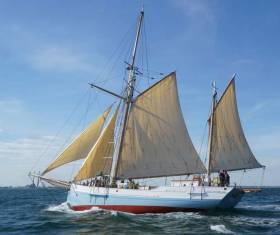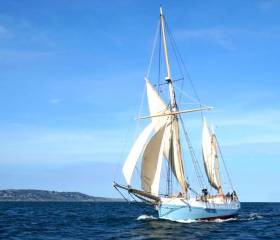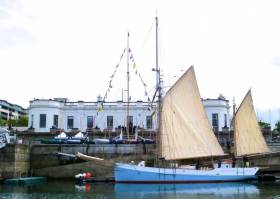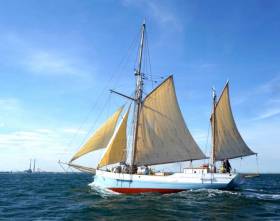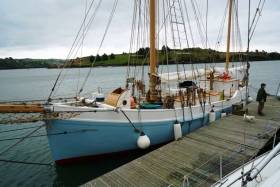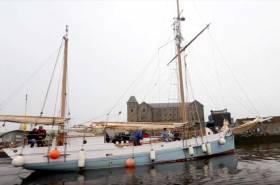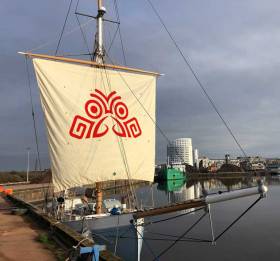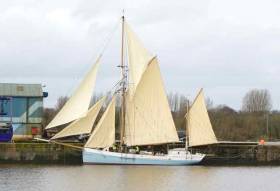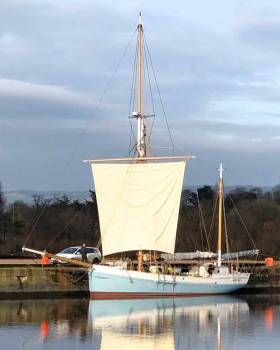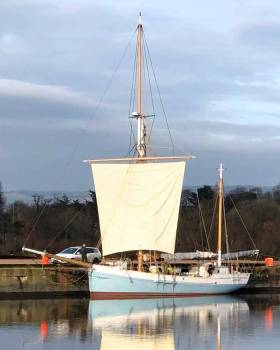Displaying items by tag: Ilen
It is 1200 nautical miles across the Atlantic from Loop Head at the north side of the long Shannon Estuary to Cape Farewell, the southernmost point of Greenland, writes W M Nixon. While the originally 1926-built ketch Ilen of Limerick may have made the much longer voyage to her working life in the Falkland Islands in the South Atlantic in her first year afloat, the voyage to Greenland will be the first time that this special little ship has been in remote northern waters.
In recent months, Ilen Project director Gary MacMahon and his team have been testing Ilen as they visited several Irish ports and fulfilled a programme implemented with the Sailing into Wellness organisaton.
But since June 18th, Ilen has been back in Limerick making final preparations for this Salmons Wake venture to Greenland, tracing the migratory routes of the Atlantic salmon. It’s a multi-faceted concept which has developed from the building of informational interactions between schools in the Limerick area and schools in southwest Greenland, going on to include maritime studies and sea monitoring, and spreading into cultural exchanges and the promotion of ancient skills.
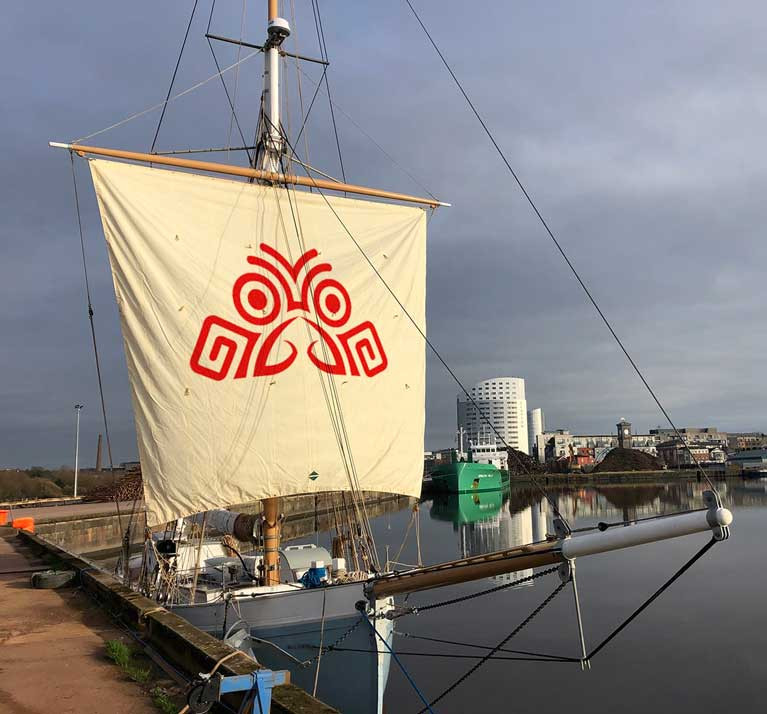 The Salmons Wake symbol inscribed on Ilen’s squaresail. Photo: Gary MacMahon
The Salmons Wake symbol inscribed on Ilen’s squaresail. Photo: Gary MacMahon
One of the purposes of the outward voyage will be the delivery of a traditional Limerick Shannon salmon-fishing cot, a creation of the Ilen Boat-Building School in Limerick city, to the people of the Greenland capital of Nuuk. And when Greenland has been reached, it has been planned that the hosts will have opportunities to sail on Ilen, while specialists in Ilen’s crew of ten will undertake mountaineering expeditions in the Nuuk locality, among several other shore ventures.
There are very many skills and special talents combined in Ilen’s ship’s complement which - for the outward voyage - will comprise Gary Mac Mahon, Paddy Barry, Mike Grimes, Mantas Seskanskis, James Madigan, Ronan O Caoimh, Breanndan Begley, Mick Ruane, Seamus O’Byrne and Justin McDonagh.
Ilen takes her departure from the Ted Russell Dock in Limerick at 5.0pm on Sunday, June 30th, and her many supporters in Ireland and worldwide will be united in good wishes for this special ship and her crew in their unique and visionary venture.
Baltimore Wooden Boat Festival Welcomes Restored Ilen Home to Her Birthplace After Historic Dublin Visit
Three million euro - every bit of €3 million writes W M Nixon. That’s what the late Theo Rye, internationally-recognised expert on the restoring and re-building of classic and traditional craft, reckoned that breathing new life into Ireland’s historic 56ft trading ketch Ilen would have cost – at the minimum - if the project had been awarded on a fully professional basis to some comprehensively equipped, properly qualified and economically efficient specialist boatyard in the heartlands of the top end of boat-building skills, in places such as The Netherlands, or at select yards around the Solent, or somewhere up in Denmark.
However, the restoration of the 1926-built Ilen, in a joint effort by the Ilen Boat-building School in Limerick and Liam Hegarty’s Oldcourt Boatyard near Baltimore, has certainly produced a fully restored little ship which exudes quality and authenticity. But thanks to special efforts by all involved, there is no way that the cost has been remotely near that jaw-dropping figure of €3 million.
Yet while the sums have been much more manageable, every cent of it has had to be secured from one source or another, and by this stage Gary Mac Mahon of Limerick – the inspiring overall promoter of the Ilen ideal – can probably fill out grant applications and benevolent funding proposals in his sleep.
 Captain Gerry Burns, shipwright Liam Hegarty and Ilen Project Director Gary MacMahon at the Ilen reception in the Royal Irish YC. Photo: Dermot Lynch
Captain Gerry Burns, shipwright Liam Hegarty and Ilen Project Director Gary MacMahon at the Ilen reception in the Royal Irish YC. Photo: Dermot Lynch
Now, however, the fact that Ilen is in full seagoing commission and properly certified - following her annual inspection by official specialists in Baltimore a fortnight ago - gives people something very tangible to grasp when support is sought.
Rather than the high-flown but inevitably vague talk of times past, and thoughts of increasing respect for Ireland’s sometimes hidden maritime traditions while also honouring the memory of Conor O’Brien whose seafaring achievements directly resulted in Ilen being built in the first place, we now have something real. A proper little ship with which we can all identify. A little ship which nevertheless still needs a steady flow of real money to keep up the good work of adding interest to international school projects, implementing programmes like Sailing Into Wellness, and giving extra meaning to environmental campaigns.
Thus last weekend’s extended visit to Dublin, with target points for shoreside interactions with well-wishers at Poolbeg Yacht and Boat Club in the Liffey, the Royal Irish Yacht Club in Dun Laoghaire, and the heart of Howth Harbour during the annual Prawn Festival, were all occasions with multiple purposes.
 When the Ilen arrived at her berth at the RIYC, it had only recently stopped raining, but by the time the reception got underway, the sun was shining. Photo: W M Nixon
When the Ilen arrived at her berth at the RIYC, it had only recently stopped raining, but by the time the reception got underway, the sun was shining. Photo: W M Nixon
At its most basic, there was the opportunity for people who had a vague feeling of goodwill towards the ship to actually see her and go aboard. Then for those who knew something of what the restored Ilen really meant, there was an opportunity to inspect and wonder at the quality of the restoration, and the skills of creative design which have been used to turn a little freight and ferry ship into a proper long distance voyager with comfortable crew accommodation, yet with enough space to be a floating classroom.
This weekend, Ilen is the star of the annual Baltimore Wooden Boat Festival. But while many memories are vivid from last weekend’s time in Dublin, there’s no doubt the highlight was the re-launch ceremony at the Royal Irish Yacht Club in Dun Laoghaire, a club with which the Foynes Island sailor Conor O’Brien from County Limerick had special links.
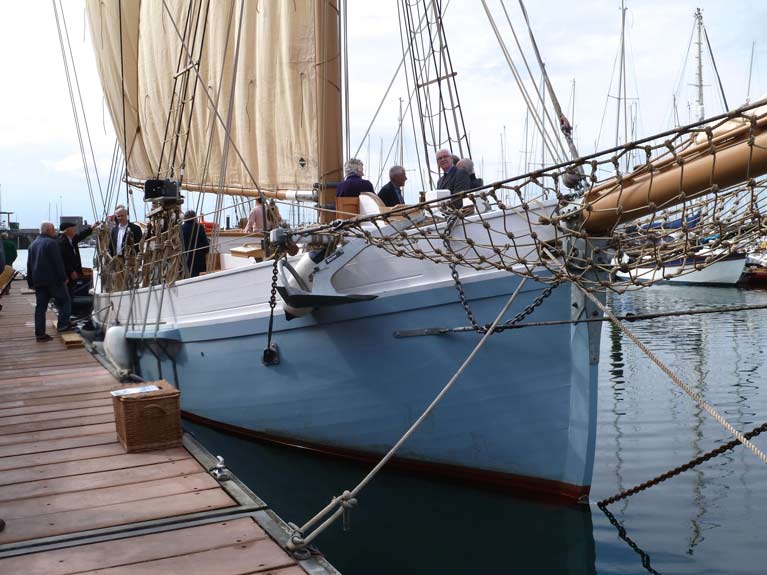 A seriously traditional ship – Ilen at the RIYC berth with the sun coming through and visitors beginning to flock on board. Photo: W M Nixon
A seriously traditional ship – Ilen at the RIYC berth with the sun coming through and visitors beginning to flock on board. Photo: W M Nixon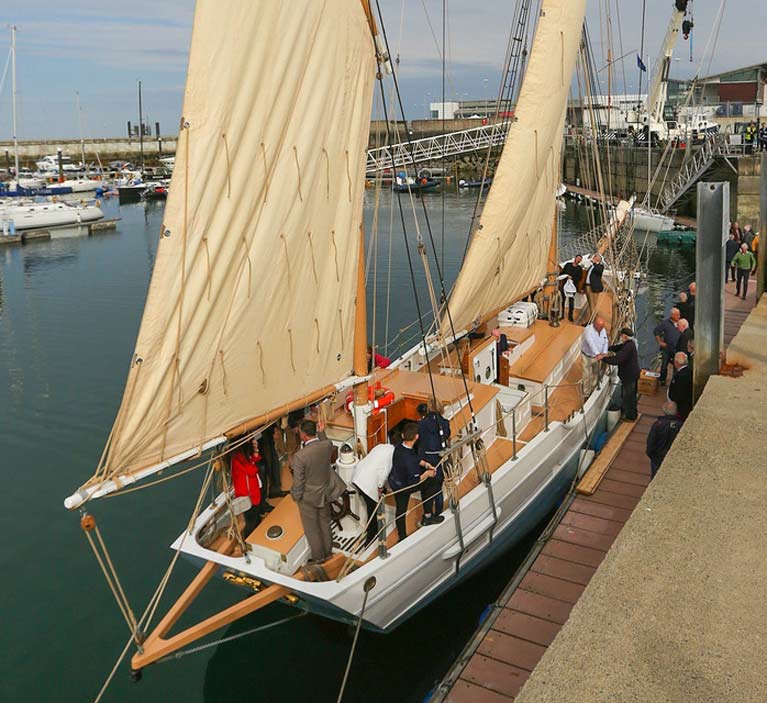 Ilen’s localised area of sunshine lasted for most of the reception at the RIYC. Photo: Deirdre Power
Ilen’s localised area of sunshine lasted for most of the reception at the RIYC. Photo: Deirdre Power
However, as this interaction was at its height in the 1920s, it’s clear that for many of today’s sailors, knowledge of O’Brien and his achievements are vague in the extreme, so the background to the story provides a useful context for the speech of welcome and encouragement which came from RIYC Commodore Joe Costello.
 RIYC Commodore Joe Costello welcomes the Ilen back to his club’s fleet after an absence of 93 years. Photo: Deirdre Power
RIYC Commodore Joe Costello welcomes the Ilen back to his club’s fleet after an absence of 93 years. Photo: Deirdre Power
Conor O’Brien of Foynes Island in the Shannon Estuary in County Limerick lived from 1880 to 1952. A grandson of William Smith O’Brien of the Young Ireland movement, he was firstly a mountaineer who then became a pioneering ocean voyager when he was the first amateur sailor to circumnavigate the world south of the Great Capes including, of course, the legendary Cape Horn.
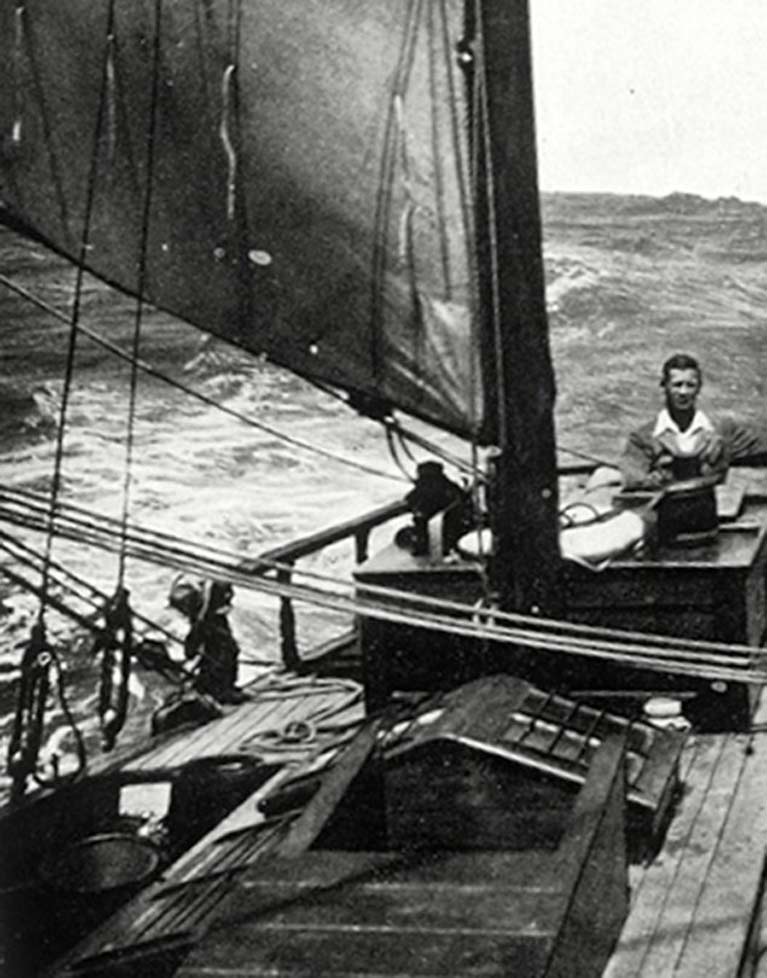 Conor O’Brien at the helm of Saoirse during the 1923-1925 round the world voyage, which began and ended at the RIYC
Conor O’Brien at the helm of Saoirse during the 1923-1925 round the world voyage, which began and ended at the RIYC
He did all this in 1923-1925 in the little 42ft gaff ketch called Saoirse, which he designed himself and had built by Tom Moynihan and his master shipwrights in Baltimore in West Cork. She was called Saoirse – “Freedom” as it is in English - to celebrate the establishment of the Irish Free State, of which he was a strong supporter – so much so, in fact, that he had aided Erskine Childers in the Howth gun-running of 1914, although he and Childers took opposing sides on the acceptance of the post War of Independence Treaty of 1921.
O’Brien withdrew from active political involvement, and instead devoted himself to getting his ideal of an ocean voyaging vessel built in Baltimore in 1922. Although he claimed that, in the first place, all his voyages really started and finished at his home port of Foynes Island, officially it was from his club, the Royal Irish YC in Dun Laoghaire on the 20th June 1923, that Saoirse’s great voyage got under way. And exactly two years later, on Saturday, June 20th 1925, Conor O’Brien and his little ship returned in triumph to this same spot, his magnificent voyage achieved.
Being a Saturday, Dublin Bay Sailing Club would normally have had a full racing programme in action. But in honour of O’Brien’s return, they cancelled racing, and their fleet provided Saoirse with a Guard of Honour as she returned to the harbour. Dublin Bay Sailing Club do not take such cancellations lightly – this was a very signal honour.
One unexpected outcome of the voyage was that when Saoirse had put into the Falkland Islands after rounding Cape Horn and sailing non-stop from New Zealand, the islanders were so impressed with the little ship’s seaworthiness that they advocated that they should have a larger version to be their inter-island ferry and freight vessel.
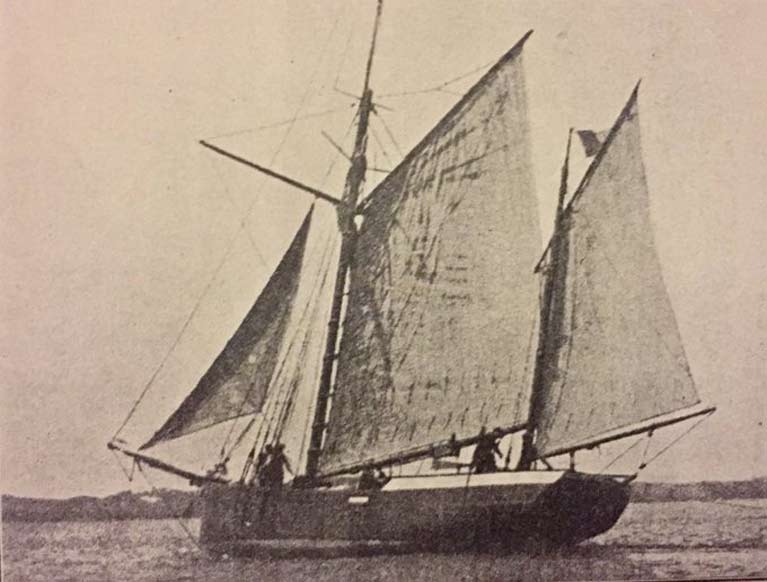 The newly-built Ilen sailing in Baltimore Harbour in 1926. Photo: Alice Foy
The newly-built Ilen sailing in Baltimore Harbour in 1926. Photo: Alice Foy
The result was that in 1926, Conor O’Brien found himself working again with Tom Moynihan in Baltimore, this time to create the 56ft ketch Ilen, which was undoubtedly Saoirse’s bigger sister.
Conor O’Brien personally delivered Ilen to the Falklands in 1926, crewed by two Cape Clear men, Con and Denis Cadogan. She was to give great service in those very rugged waters as a workboat for many decades, and when she was finally retired in the 1990s, Gary Mac Mahon of Limerick - who is both a Conor O’Brien enthusiast and a very considerable force of nature - decided that she should be shipped home to Ireland and restored to full seagoing condition in order to undertake voyaging with people who would benefit from such an experience, and also to remind us of our sometimes forgotten but nevertheless very great maritime traditions.
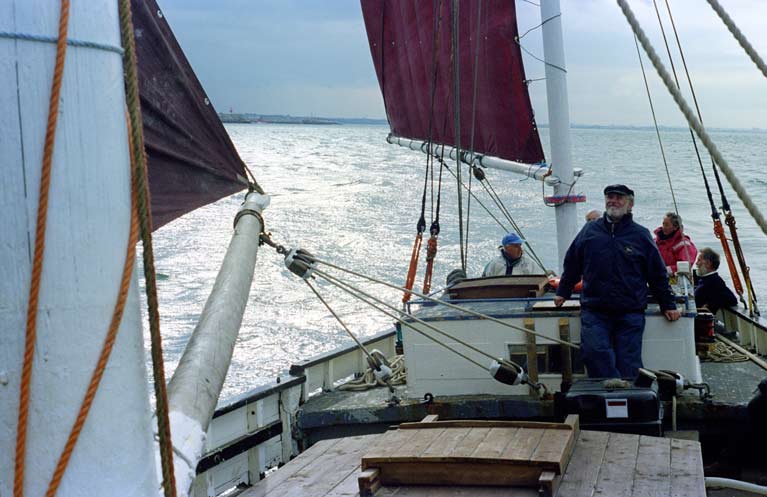 Aboard Ilen sailing in Dublin Bay in May 1998, a few months after she’d been shipped back from the Falklands. At the deckhouse and living for the moment is Tim Magennis, possibly the only person in Ireland today who has sailed round the world under gaff rig Photo: W M Nixon
Aboard Ilen sailing in Dublin Bay in May 1998, a few months after she’d been shipped back from the Falklands. At the deckhouse and living for the moment is Tim Magennis, possibly the only person in Ireland today who has sailed round the world under gaff rig Photo: W M Nixon
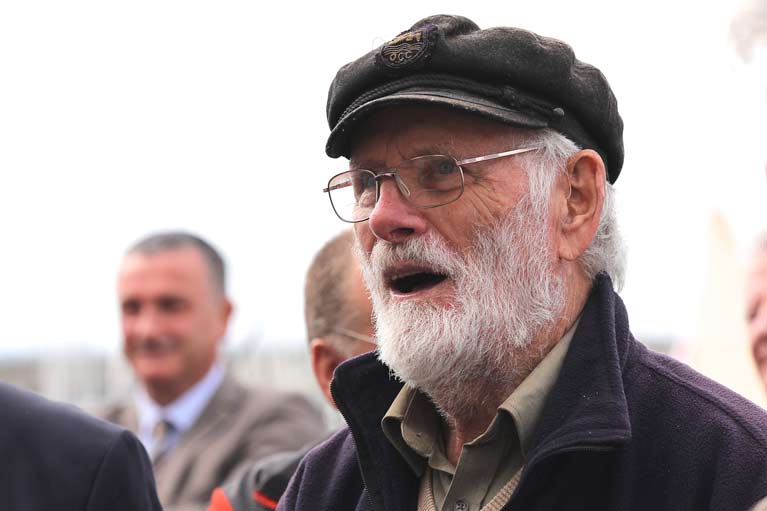 Tim Magennis – who recently celebrated his 90th birthday – at the RIYC after seeing the restored Ilen for the first time. Photo: Dermot Lynch
Tim Magennis – who recently celebrated his 90th birthday – at the RIYC after seeing the restored Ilen for the first time. Photo: Dermot Lynch
It was in November 1997 that Ilen was brought home. The fact that two decades later she was finally making her debut in this superbly restored style at the Royal Irish Yacht Club was doubly appropriate. Not only had Conor O’Brien used this as his start and finish point for his Saoirse circumnavigation in 1923-25, but when he came to deliver Ilen to the Falklands in 1926, he discovered that he was only insured as a Yachtmaster, and not as the Captain of a commercial vessel.
So when Ilen sailed out over the many thousands of miles of ocean to the Falklands, it was as part of the fleet of the Royal Irish Yacht Club – she flew the club burgee, and her club allegiance was proudly inscribed across her transom.
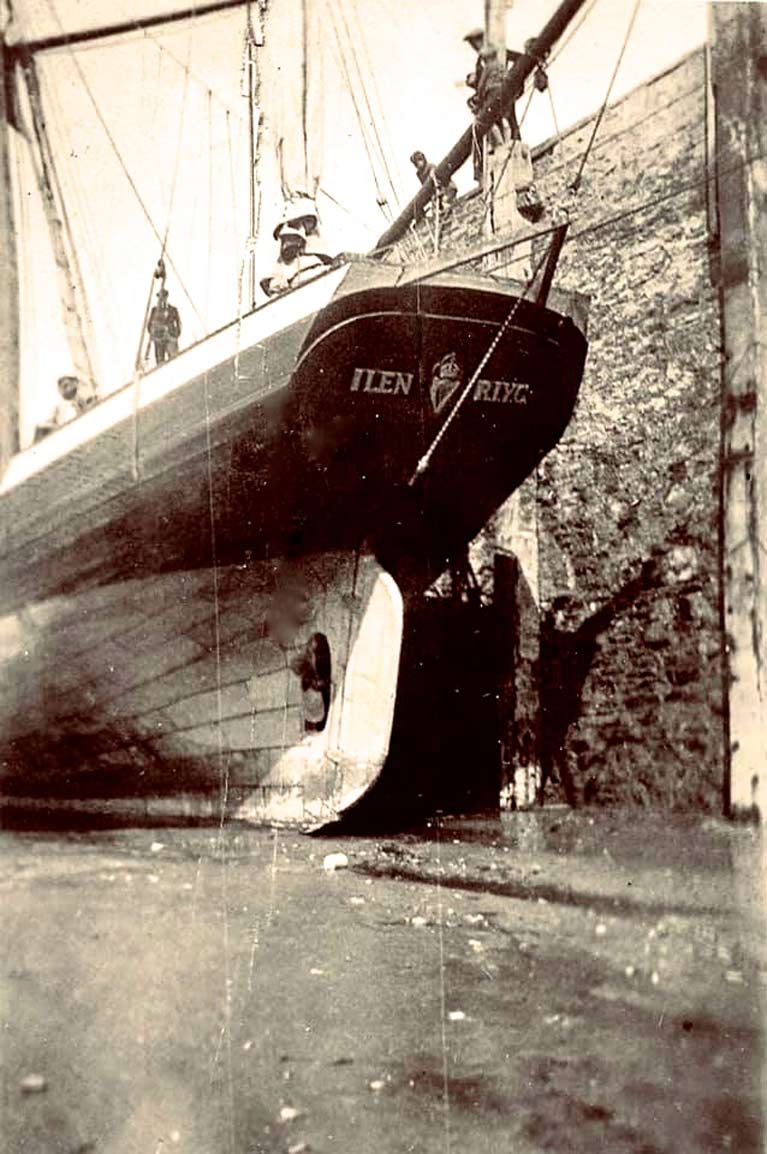
For six months, she was a yacht of the RIYC. Then she belonged in Port Stanley, and was a working boat. But now she is a Limerick ship. A little ship, perhaps, but undoubtedly a ship nevertheless, and a characterful one at that. She is very expressive of Conor O’Brien’s notions of what a hard-working seagoing vessel should look like, particularly in the matter of bowsprits. Like Saoirse before her, Ilen has a bowsprit which extends into the middle of next week, for that is the O’Brien way.
As we’re now in 2019, it is self-evident that the restoration of Ilen has been a long and challenging task, at times run on a shoestring. But thanks to the profound faith of Gary and his friends, Ireland has got to this remarkable stage of having a fully-certified seagoing traditional vessel which is currently in the midst of one of the very commendable Sailing into Wellness programmes,
 Although Conor O’Brien had no children of his own, his relatives are spread throughout Ireland – this is his grandniece Charlotte O’Brien Delamer with Stephanie O’Brien in Dun Laoghaire. Photo: Dermot Lynch
Although Conor O’Brien had no children of his own, his relatives are spread throughout Ireland – this is his grandniece Charlotte O’Brien Delamer with Stephanie O’Brien in Dun Laoghaire. Photo: Dermot Lynch
Then in July she’ll undertake a nine week educational voyage to Greenland from Limerick in the wake of the Atlantic salmon - a timely reminder of that splendid fish’s threatened status – while at the same time strengthening links which the Ilen Network has been building up between schools in the greater Limerick area and schools in southwest Greenland.
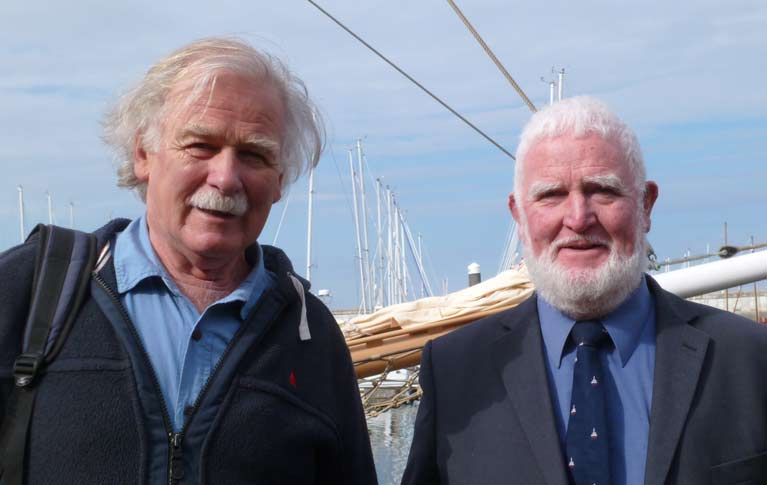 Experienced sailors of the west – Mick Brogan (left) and Jarlath Cunnane of Mayo will play a key role in bringing Ilen back from Greenland. Photo: W M Nixon
Experienced sailors of the west – Mick Brogan (left) and Jarlath Cunnane of Mayo will play a key role in bringing Ilen back from Greenland. Photo: W M Nixon
For the Ilen is now the symbol of a broad movement which has re-kindled awareness of the unique traditional vessels of Ireland, particularly those of the Shannon Estuary and West Cork. But were it not for this wonderful vessel at the centre of it all, the entire project would lack focus.
With the extraordinary balance of talents and almost magical chemistry between Gary Mac Mahon and Liam Hegarty and their respective teams, this restoration of exceptional authenticity has been achieved, aided in no small way by the spiritual support and guidance of Brother Anthony Keane of Glenstal Abbey.
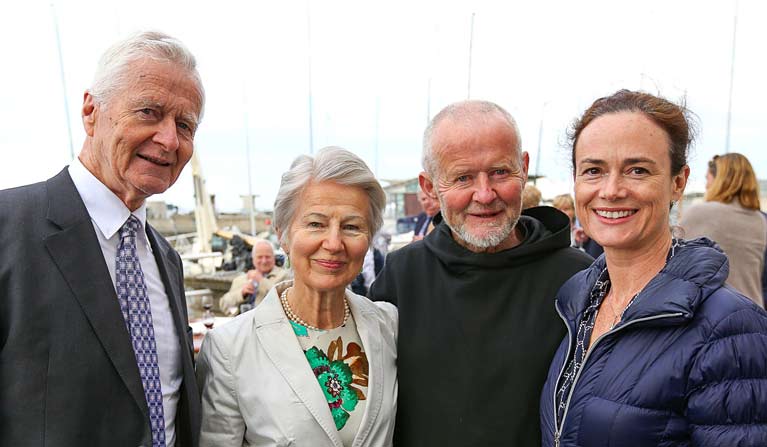 Celebrating the Ilen restoration at RIYC were (left to right) Patrick Keane SC, Deirdre Kinlen, Brother Anthony Keane of Glenstal Abbey, and Dr Sheila Javaepour. Photo: Donal Lynch
Celebrating the Ilen restoration at RIYC were (left to right) Patrick Keane SC, Deirdre Kinlen, Brother Anthony Keane of Glenstal Abbey, and Dr Sheila Javaepour. Photo: Donal Lynch
So we now have a proper flagship for the traditional and classic boat movement in Ireland, and we have a symbol for a form of sailing which is accessible to all - as such, the Ilen Project received the warmest praise from President Michael D Higgins when he visited the ship in Limerick last October.
This high-powered support for the “Ilen Ideals” was much in evidence at Dun Laoghaire’s gathering, where the presence of Dr Edward Walsh, founder of the University of Limerick, was matched by people like former RIYC Commodore Terry Johnson, whose remarkable record of service to sailing is augmented by work he has done on behalf of sail training, the lifeboat service, and other key pillars of the maritime world.
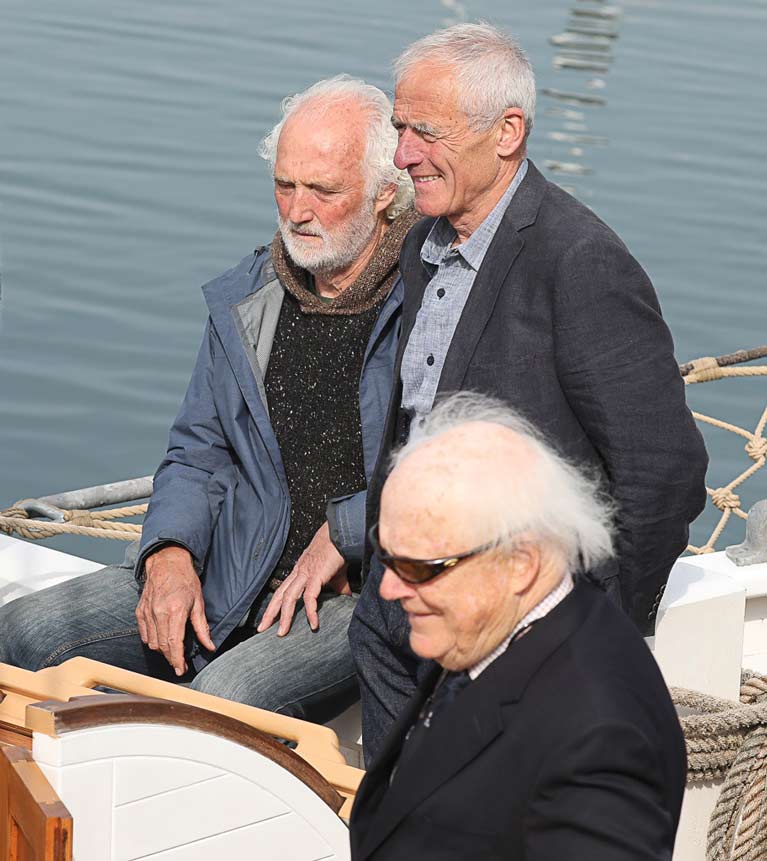 Former RIYC Commodore and maritime multi-tasker Terry Johnson (foreground) with renowned musician Brendan Begley (left) aboard Ilen. Photo: Dermot Lynch
Former RIYC Commodore and maritime multi-tasker Terry Johnson (foreground) with renowned musician Brendan Begley (left) aboard Ilen. Photo: Dermot Lynch
Also present were people who have given much practical assistance, such as Captain Gerry Burns of Irish Ferries, who in his leave periods served as a relief captain on the training Ship Asgard II. Since Ilen went afloat again, he has been journeying to Limerick to give master-classes in ship-handling to future Ilen skippers.
Another attendee was Tim Magennis, one of the few people who has sailed right round the world under gaff rig. When Ilen sailed briefly in Dublin Bay in May 1998 after she had been shipped back from the Falklands, Tim - a stalwart of the Old Gaffers Association – was one of those on board, and now 21 years later, having recently celebrated his 90th birthday, his delight in Ilen’s restoration was a joy to behold.
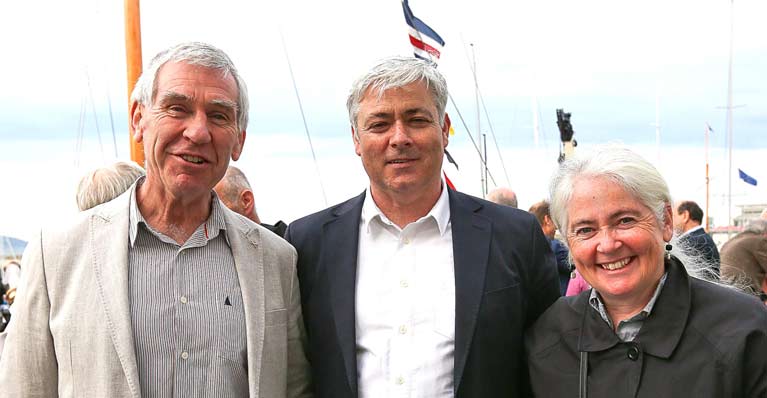 Ilen Project supporter Harry Harbison, Gary Mac Mahon, and Sheila Deegan, Arts Officer of Limerick City & County Council. Photo: Dermot Lynch
Ilen Project supporter Harry Harbison, Gary Mac Mahon, and Sheila Deegan, Arts Officer of Limerick City & County Council. Photo: Dermot Lynch
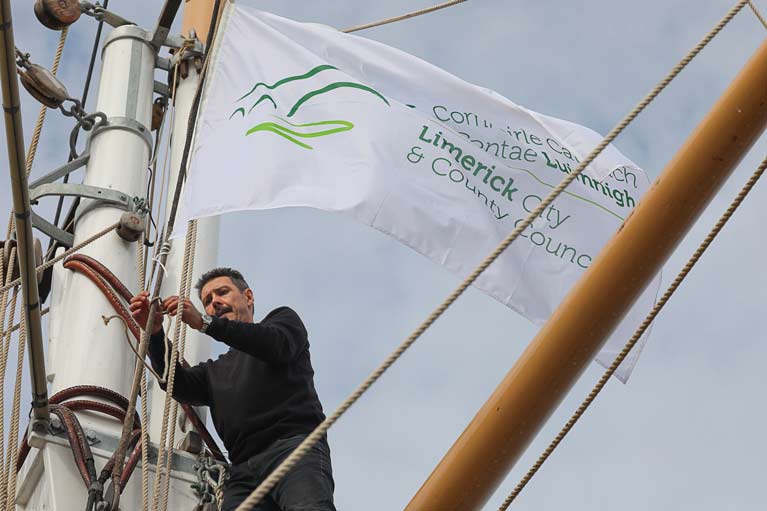 Rigging expert Trevor Ross ensures that the Limerick flag is aloft and flying. Photo: Dermot Lynch
Rigging expert Trevor Ross ensures that the Limerick flag is aloft and flying. Photo: Dermot Lynch
Although Conor O’Brien had no children, many people are related to him, and among those present were Charlotte O’Brien Delamer, his grandniece, and Stephanie O’Brien, married to another O’Brien relative.
For them, restoration of the Ilen was an intensely personal matter. But it was equally clear that many folk attending the RIYC reception found it especially moving that Ilen had been restored, and had now come to visit the club which meant so much to Conor O’Brien’s sailing.
Yet she’s a busy ship. Soon it was time to move on to Howth for a visit arranged by Wally McGuirk, where on Monday morning skipper Paddy Barry took a group of trainees from the inner-city Westland Row CBS out for some sailing experience on Ilen arranged through the Atlantic Youth Trust. Then in the afternoon, it was time to depart for Baltimore with the gift of a tankful of diesel from Howth Boat Club, on down to West Cork where the Wooden Boat Festival will serve up its own quota of emotional associations.
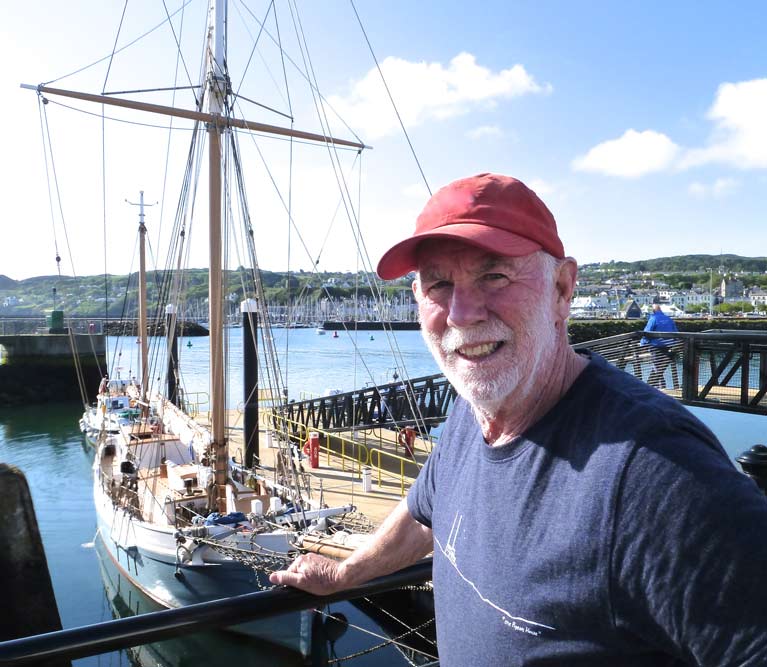 High latitudes veteran Paddy Barry with the Ilen in Howth on Monday morning. He’ll be aboard for the entire nine weeks voyage to Greenland. Photo: W M Nixon
High latitudes veteran Paddy Barry with the Ilen in Howth on Monday morning. He’ll be aboard for the entire nine weeks voyage to Greenland. Photo: W M Nixon
As a reminder of how things have slowly but steadily progressed, here’s a video by Paul Fuller of the then recently-launched and still largely unballasted Ilen making her debut at last year’s Festival in Baltimore. Now she is in full properly-ballasted seagoing order, ready and willing for further work at home before the voyage to Greenland gets underway from Limerick in July. It’s anticipation of this which will give the Baltimore Wooden Boat Festival 2019 an added dimension and an even more vivid flavour.
In 1926, the newly-built 56ft trading ketch Ilen was for six months part of the fleet of the Royal Irish Yacht Club. Built in Baltimore in West Cork under the inspiration of pioneering global circumnavigator Conor O’Brien of Limerick to be the ferry and freight vessel for the very distant Falkland Islands, Ilen was of course ultimately going to be a working vessel. But as part of the contract stipulated that she be delivered to the Falklands under Conor O’Brien’s command, because his seagoing qualification was only as a yachtmaster and not a professional skipper, the only way insurance could be secured was through the new vessel’s registration as a yacht.
Conor O’Brien was of course already a highly-regarded member of the RIYC, as his famous 1923-1925 global circumnavigation with the 42-ft Saoirse (built in Baltimore in 1922) had officially started and finished from the Royal Irish clubhouse. Thus in 1926 the authorities in both club and officialdom readily agreed to Ilen having yacht status, and the voyage was completed flying the RIYC burgee.
During the long restoration programme for Ilen during the past decade and more under the partnership of the Ilen Boat-building School of Limerick under Gary MacMahon’s direction, and the renowned boatyard at Oldcourt near Baltimore run by Liam Hegarty, the thought was always there that when Ilen had been re-created in authentic style as a research and educational vessel, she should “make her number” back at the club where she was briefly part of the fleet 93 years ago, even though Limerick is now her home port.
After a swift voyage up from Baltimore last weekend, Ilen had been berthed in Dublin at Poolbeg, but on Friday she crossed the bay and preparations began for the reception at the RIYC. Even the unsettled weather cleared locally to provide sunshine for the welcome by RIYC Commodore Joe Costello, his fellow flag officers and many members, in addition to dozens of special guests who were there to see the superb restoration project completed with a very special ship, and to help the Ilen ideal on its way.
WM Nixon’s Sailing on Saturday blog on May 25th will link Ilen to this coming weekend’s Baltimore Wooden Boat Festival and take a more in-depth look at the remarkable attendance during her welcome to the RIYC.
Fair Winds for Ilen to Dublin Bay
The Limerick Ketch Ilen arrived back at Dublin yesterday after a 21-year absence. She departed Dunmore East on Friday, where she had been joined by a group from Aiséirí, a dynamic residential treatment centre for adults affected by addiction.
This ‘voyage of recovery' was organised by Sailing into Wellness, the organisation with a mission towards inspiring positive change in individuals and communities through the medium of the sailing upon the sea.
The Ilen Project, which operates the Ilen as a community learning platform, also supports similar organisation who share its mission and values, and all involved are more than happy with collaboration with Sailing into Wellness making this voyage towards Dublin a success.
Historic Ketch Ilen Heading for Official Launch in Dun Laoghaire to Create Pride in Preserving Maritime History
The Ilen will be setting course for Dublin this weekend for a high profile launch at Dun Laoghaire on Friday of next week.
She arrived at Kinsale this Wednesday night after what was described as a “bouncy bouncy run from Baltimore,” to rest a for a day and then sail toward Dublin this weekend, depending upon weather conditions.
The plan is for a “launch” ceremony for what is described as “the rebuilt auxiliary ketch,” at the Royal Irish Yacht Club in Dun Laoghaire on Friday next, May 17.
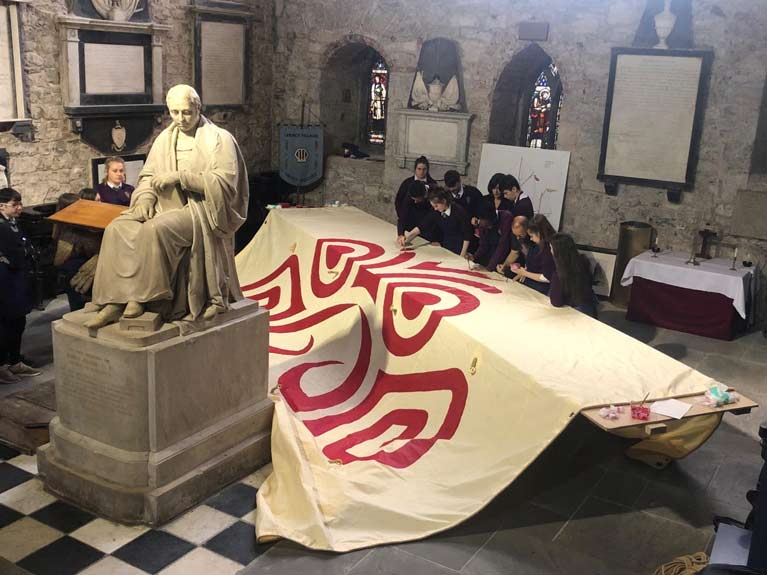 Ilen's educational salmon sail being painted by school children in St.Mary's Cathedral in Limerick
Ilen's educational salmon sail being painted by school children in St.Mary's Cathedral in Limerick
I have been following the impressive restoration of Ireland’s last trading ketch since she returned from the Falkland Islands, a unique vessel which should evoke pride in the preservation of our maritime history.
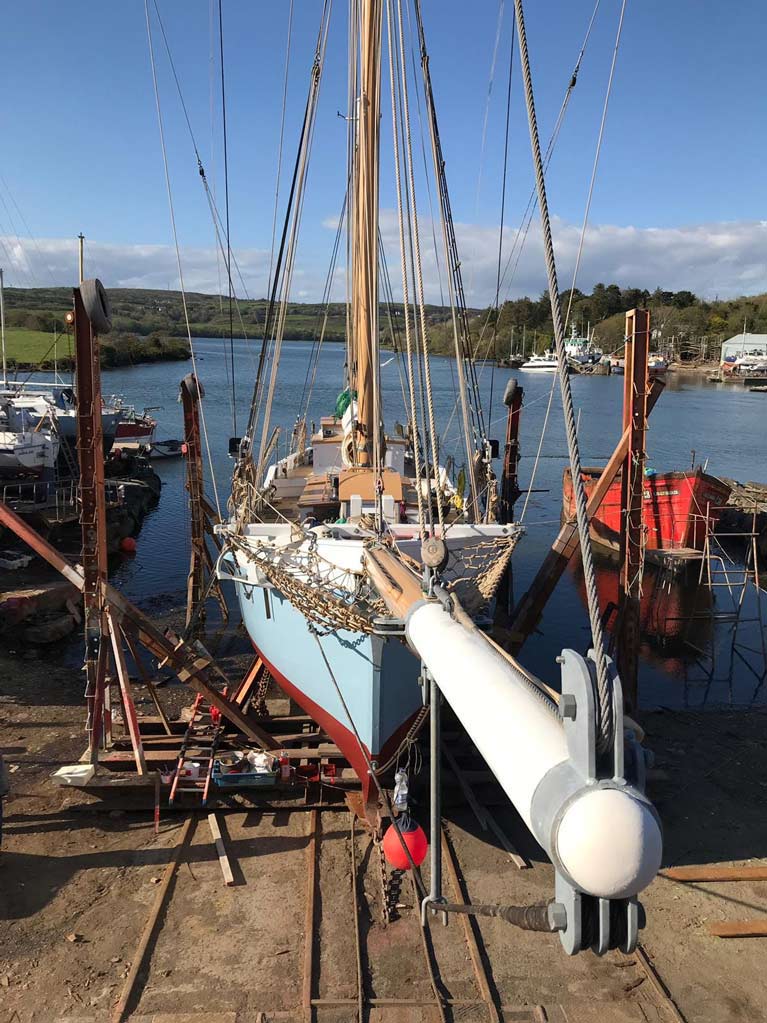 Ilen at Hegarty's Boatyard in West Cork
Ilen at Hegarty's Boatyard in West Cork
She has had her hull and square sail painted and looked great at Kinsale under the command of the south-coast James Lyons (Sailing into Wellness). In Dublin, she will be sailed into the waiting hands of Paddy Barry and an east-coast crew. The hull was painted at Hegarty’s Boatyard, Oldcourt, Skibbereen, where she was restored and the square sail at St. Mary’s Cathedral, Limerick, the sail emblazoned with the new symbol for Ilen's educational programme - Salmon’s Wake - a migratory wild Salmon amid the vast North Atlantic … Gary McMahon, whose determination has led the long and successful restoration project, says its educational programme will renew interest in Irish maritime culture and explained the focus on salmon. At the start of a sailing and community educational season and all from voluntary and community endeavour, this is project is setting an example for what can be achieved by determination.
• Listen to Gary McMahon on the Podcast below
Ilen Departs Limerick for Summer Voyages
The historic ketch Ilen of Limerick put to sea again from her home port on April 20th at the beginning of a complex 2019 sailing programme which will see the restored ship voyage in July towards southwest Greenland.
Check out the video below to see Ilen depart Limerick City down the Lower Shannon and on towards Baltimore, West Cork.
She’ll be following in the wake of the migratory salmon which have journeyed since time immemorial between the Shannon and Greenland’s only salmon river, the Kapisillit at the head of a fjord at Nuuk, Greenland’s capital and Ilen’s primary destination.
The historic ketch Ilen of Limerick puts to sea again from her home port this weekend at the beginning of a complex 2019 sailing programme which will see the restored ship voyage in July towards southwest Greenland writes W M Nixon. She’ll be following in the wake of the migratory salmon which have journeyed since time immemorial between the Shannon and Greenland’s only salmon river, the Kapisillit at the head of a fjord at Nuuk, Greenland’s capital and Ilen’s primary destination.
Ireland’s last surviving sailing trading ketch, the 1926-built 56ft Ilen was originally designed by global circumnavigator Conor O’Brien to be the inter-island freight and ferry vessel in the Falkland Islands, and he sailed her out there after she’d been built by Tom Moynihan and his men at the Fishery Schools in Baltimore. When Ilen was retired from active service in the islands in the 1990s, Conor O’Brien enthusiast Gary Mac Mahon of Limerick set about trying to bring her home for restoration.
In November 1997 he achieved his first goal when Ilen was finally lifted off a ship in Dublin Docks. After wintering in the city’s Grand Canal basin, she sailed for the first time in many years in Dublin Bay in May 1998, and soon made the passage to West Cork for the Baltimore Wooden Boat Festival and the Glandore Classics Regatta.
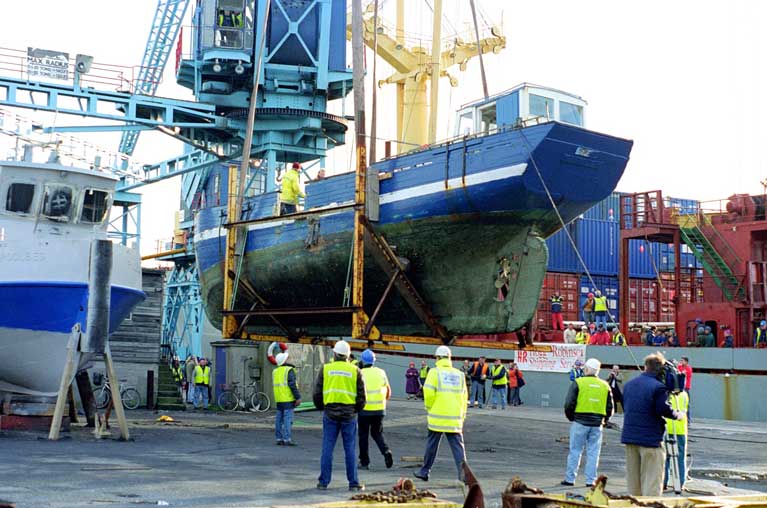 Ilen unloaded in Dublin Docks, November 1997 Photo: W M Nixon
Ilen unloaded in Dublin Docks, November 1997 Photo: W M Nixon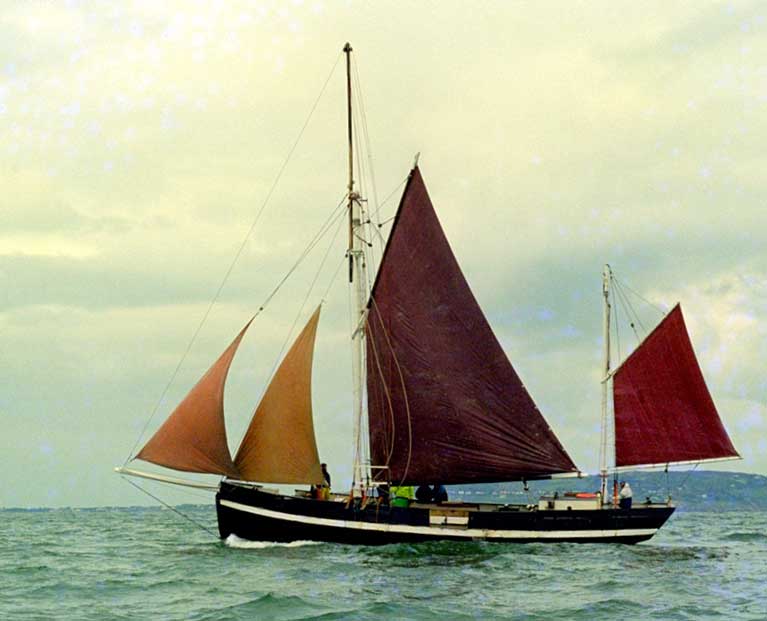 Ilen under sail for the first time in very many years, Dublin Bay May 1998. Photo: W M Nixon
Ilen under sail for the first time in very many years, Dublin Bay May 1998. Photo: W M Nixon
 Paddy Barry and Jarlath Cunnane aboard Ilen in Dublin Bay, May 1998. They are still very much involved in the Ilen Project. Photo: W M Nixon
Paddy Barry and Jarlath Cunnane aboard Ilen in Dublin Bay, May 1998. They are still very much involved in the Ilen Project. Photo: W M Nixon
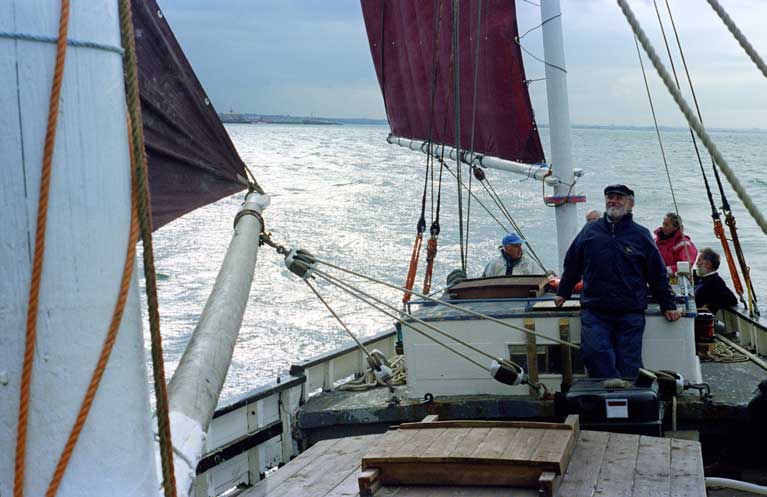 Aboard Ilen on that historic sail in Dublin Bay in May 1998 were several classic and traditional boat enthusiasts, including (left) Fionan de Barra, with Tim Magennis at deckhouse and Paddy Barry on the right. The restored Ilen returns to Dublin Bay in May 2019. Photo: W M Nixon
Aboard Ilen on that historic sail in Dublin Bay in May 1998 were several classic and traditional boat enthusiasts, including (left) Fionan de Barra, with Tim Magennis at deckhouse and Paddy Barry on the right. The restored Ilen returns to Dublin Bay in May 2019. Photo: W M Nixon
However, it was obvious that a huge project of restoration work was required to make the ship compliant with survey requirements for regular sea-going, and for several years she was virtually moth-balled. But in time a programme was devised – the Ilen Project – whereby the main hull restoration would be undertaken by master shipwright Liam Hegarty at Oldcourt Boatyard on the Ilen River above Baltimore in West Cork, while 180-kilometres away in Limerick, Gary Mac Mahon and the Ilen Network established an international project, the Ilen Boat-Building School, which made many of the detailed items such as the hatches and deckhouses, and the spars and rigging came out of this extensive Limerick workshop as well.
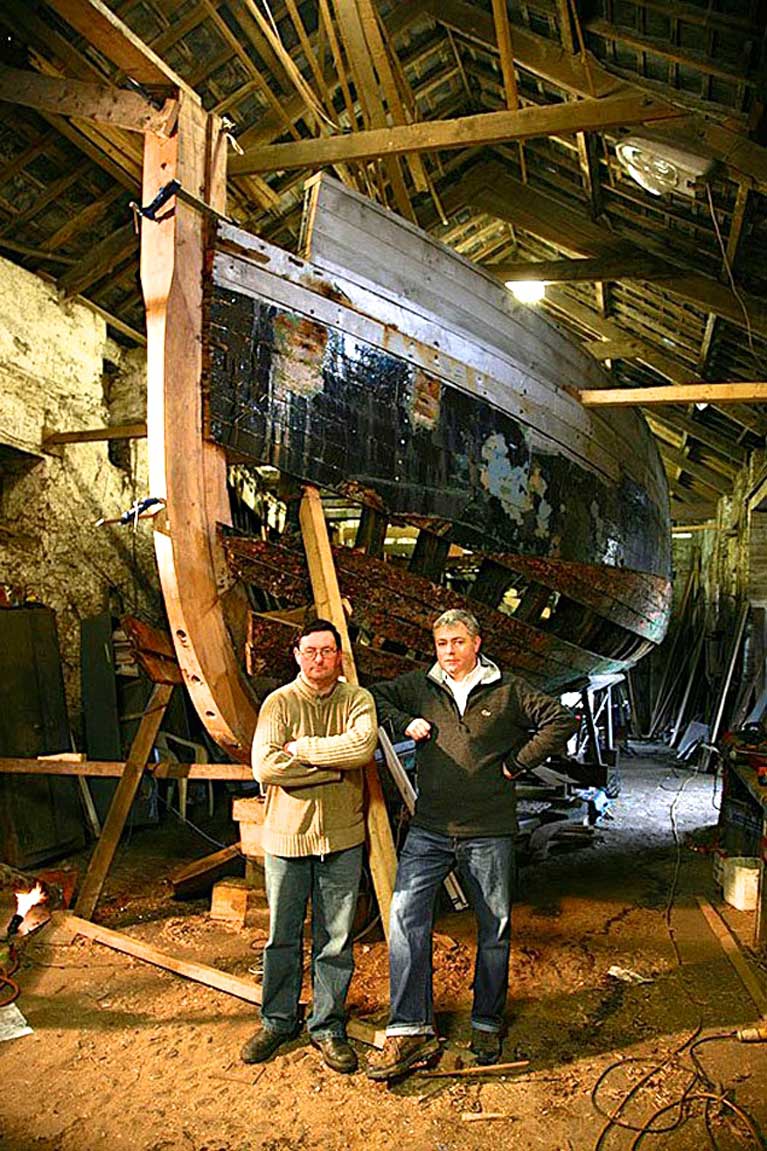 Liam Hegarty (left) and Gary Mac Mahon at an early stage of Ilen’s hull restoration in Oldcourt
Liam Hegarty (left) and Gary Mac Mahon at an early stage of Ilen’s hull restoration in Oldcourt
All that work was in addition to other smaller boat-building projects undertaken in the School by a wide variety of trainees, many from an international background. These included a new fleet of the traditional Shannon gandelows, and other small craft including a Shannon angling cot and a flotilla of the economically-built yet very effective CityOne sailing dinghies, designed by the late naval architecture legend Theo Rye, who was an enthusiast for the entire Ilen programme.
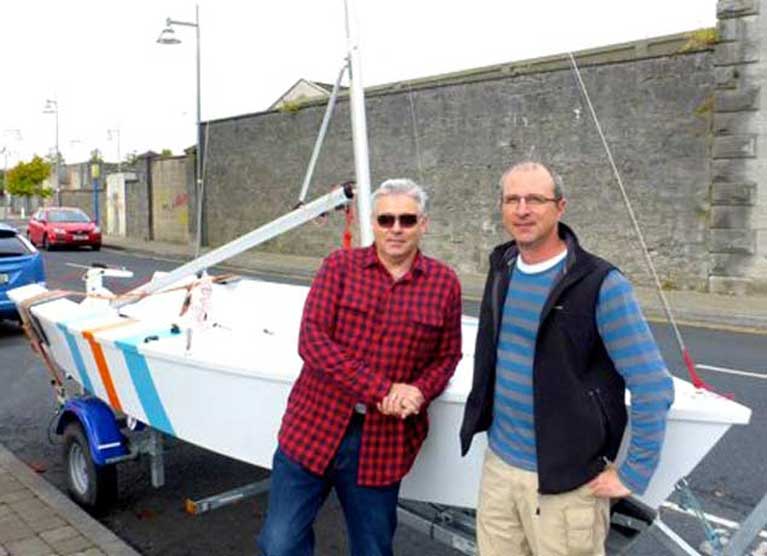 Gary MacMahon with the late Theo Rye and a new CityOne sailing dinghy in Limerick. Photo: W M Nixon
Gary MacMahon with the late Theo Rye and a new CityOne sailing dinghy in Limerick. Photo: W M Nixon
The Ilen Project in its broadest sense was by no means a matter of never-ending boat-building work. There was fun to be had. The gandelows were regular visitors to the Baltimore Woodenboat Festival as well as other events back north on the Shannon Estuary, while the CityOnes made their mark at the Glandore Classics and several regattas. Two of the Ilen seniors, Liam O’Donoghue and Tony Daly, travelled the length of the Erne and the Shannon from Belleek in Fermanagh to Limerick in an angling cot they’d built in the school, and of course when the Thousandth Anniversary of the Battle of Clontarf came up in 2014, as defenders of the proud Limerick memory of Brian Boru, the Ilen gandelow crews and their boats had to put in triumphant appearance on Dublin Bay.
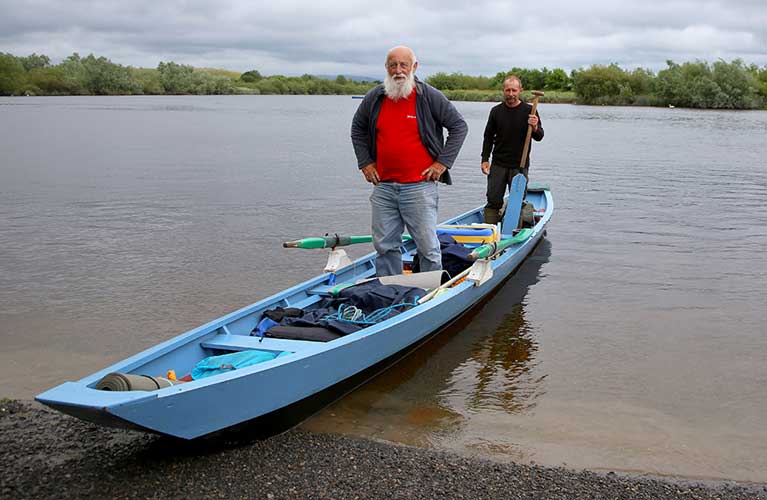 Liam O’Donoghue and Tony Daly with the Ilen School-built Shannon Angling Cot they rowed from Belleek in Fermanagh via the Erne and the Shannon all the way to Limerick
Liam O’Donoghue and Tony Daly with the Ilen School-built Shannon Angling Cot they rowed from Belleek in Fermanagh via the Erne and the Shannon all the way to Limerick
However, undoubtedly the most off-the-wall episode was taking the gandelows to one of the Festivals of the Sea in Venice. Folk from elsewhere may come up with ready wisecracks about “gandelow” being no more than the Limerick version of “gondola”, yet the citizens of the Serenissima went out of their way to make the Limerick crews and their boats welcome, and the entire visit was carried out with style and elan.
 The new traditional Shannon gandelows built by the Ilen School made a memorable visit to Venice.
The new traditional Shannon gandelows built by the Ilen School made a memorable visit to Venice.
But meanwhile, as resources permitted the restoration work on Ilen’s hull continued. The detailed joinery-work built in Limerick was added in as required, and finally, in January 2018, Ilen emerged re-born from the old Top Shed at Oldcourt. There was still much work to be done, but she was able to put in an appearance at the Baltimore Woodenboat Festival in May, and then finally at the end of September she was sufficiently ready for sea to voyage round to her home port of Limerick where, in a hectic first week of October, visiting well-wishers included President Michael D Higgins and his wife, Sabina.
![]() Finally brought together – the restored Ilen off Baltimore Beacon, September 2018. While the hull had been restored in Oldcourt, everything above deck except the sails had been made in Limerick. Photo: Declan Lynch
Finally brought together – the restored Ilen off Baltimore Beacon, September 2018. While the hull had been restored in Oldcourt, everything above deck except the sails had been made in Limerick. Photo: Declan Lynch
Ilen had spent all her life as a working boat, but now that she was so superbly restored, there was no way she was going to be treated as an ornament. On the contrary, it was planned that she would work in the areas of education, special assistance, and national and international cultural interaction, helping people young and old to develop as they learned to understand the ways of the past, the lore of seafaring, the story of Limerick’s magnificent waterborne trading history, and the mysteries and wonders of nature.
In an age of multi-faceted, continuous and wall-to-wall entertainment – electronic and otherwise – this was a tall order, and a “Big Idea” was needed to bring it into focus. Early projects with a variety of schools and other groups in the Greater Limerick area have produced encouraging results. It was and is evident that interacting with something as tangible as a traditional sailing vessel in almost any way can be a very rewarding experience for those new to it, and so the idea developed that a major flagship project for the summer of 2019 would clarify the focus on Ilen and all that she did – and all that she might do, too.
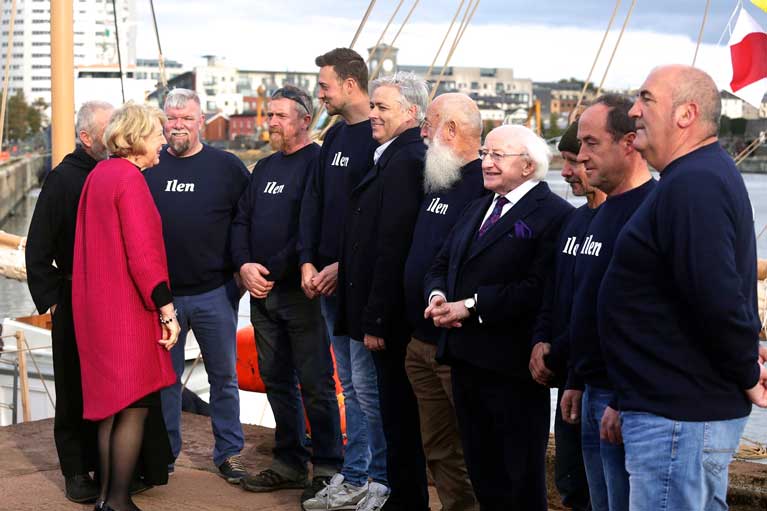 Almost immediately after returning to Limerick last October, Ilen enjoyed a Presidential visit
Almost immediately after returning to Limerick last October, Ilen enjoyed a Presidential visit
In an era of increasing awareness of the environment and the need for conservation and climate awareness, the “Big Idea” was right there, hidden in plain sight. While the numbers of Atlantic salmon passing through Limerick may have decreased markedly since the Ardnacrusha dam was built in the late 1920s and for other reasons, the salmon in the Shannon going to and from the sea are still very much part of the city’s culture. And it is known that while Atlantic salmon migrate to many rivers in several countries, in all of Greenland, they go to only one, the Kapisillit.
So why not sail Ilen in the salmon’s wake to this one special river with an Ilen Boat Building School-constructed Shannon angling cot as deck cargo, and thereby create a unique link around which a vibrant cultural interaction can be built between the schools and young people of Limerick and their counter-parts in southwest Greenland? The idea took hold, and it has developed as a busy project with schools in the greater Limerick area.
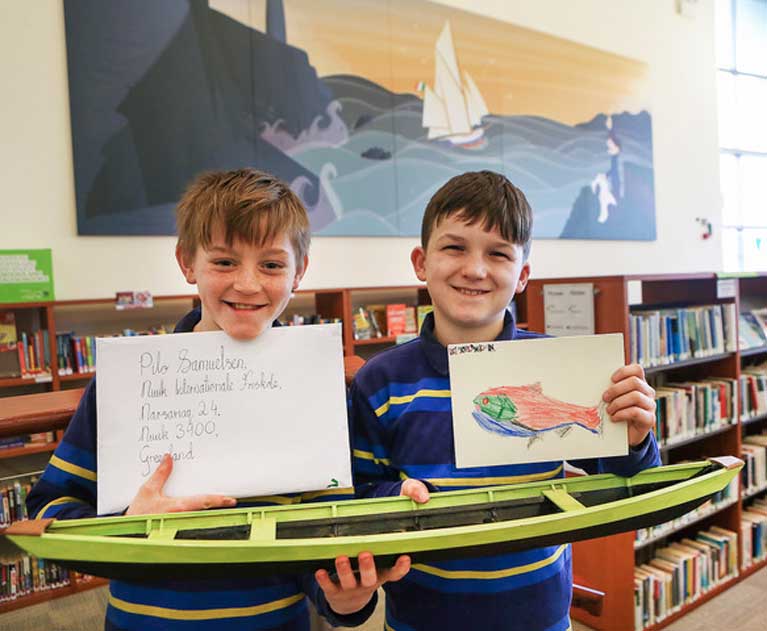 In anticipation of the Salmon’s Wake voyage, schools in Limerick have been exchanging letters with their new pen-pals in Greenland
In anticipation of the Salmon’s Wake voyage, schools in Limerick have been exchanging letters with their new pen-pals in Greenland
This ambitious Salmons Wake Voyage will take over Ilen’s 2019 programme at the end of June. But meanwhile, the first part of the 2019 season involves Ilen interacting with the Sailing Into Wellness movement, with a series of short voyages along Ireland’s south and east coasts.
To position her for this and as part of the preparations for the Greenland voyage, over this Easter Weekend she’ll be making the passage from Limerick back to Baltimore and the Oldcourt Boatyard for a pre-season haul on Tuesday with a hull inspection, following which she’ll be making coastal passages with Sailing Into Wellness via ports such as Kinsale, Waterford and Howth until on Friday, May 17th she’s in Dun Laoghaire for a major presentation.
After that, the Sailing Into Wellness programme continues with a return to West Cork and the Baltimore Woodenboat Festival (24th May to 26th May), with an SIW Ilen base then established in Kinsale. But as June progresses, the ship will return to Limerick with preparations for the nine-week Greenland voyage being finalised.
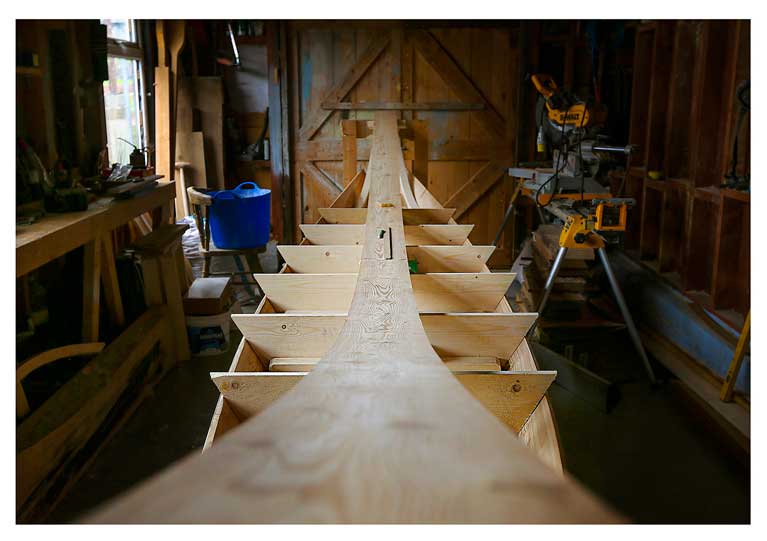 This traditional angling cot, currently in build at the Ilen School in Limerick, will be taken to Greenland as deck cargo on the Ilen. Photo: Gary MacMahonCommunication with the local Greenland community and two schools in Nuuk has been active, and in July it is planned that Deirdre Power of the Ilen Project and artist Chelsea Canavan from Limerick will be in residence in Nuuk to help in co-ordinating Ilen’s reception. That will include the visit to the Kapisillit River where the new-built Shannon angling cot currently being created by the Ilen Boat-Building School and brought to Nuuk by Ilen herself as deck cargo will be put afloat as a tangible symbol of many interacting links.
This traditional angling cot, currently in build at the Ilen School in Limerick, will be taken to Greenland as deck cargo on the Ilen. Photo: Gary MacMahonCommunication with the local Greenland community and two schools in Nuuk has been active, and in July it is planned that Deirdre Power of the Ilen Project and artist Chelsea Canavan from Limerick will be in residence in Nuuk to help in co-ordinating Ilen’s reception. That will include the visit to the Kapisillit River where the new-built Shannon angling cot currently being created by the Ilen Boat-Building School and brought to Nuuk by Ilen herself as deck cargo will be put afloat as a tangible symbol of many interacting links.
With such a programme, which will see Ilen sail between 5,000 and 6,000 miles by season’s end and dozens of ports visited, obviously very many people will be actively involved at different stages. But for the major ocean voyages, Gary Mac Mahon has been able to call on the services of a unique group of people who combine traditional boat sailing skills with extensive Arctic voyaging experience.
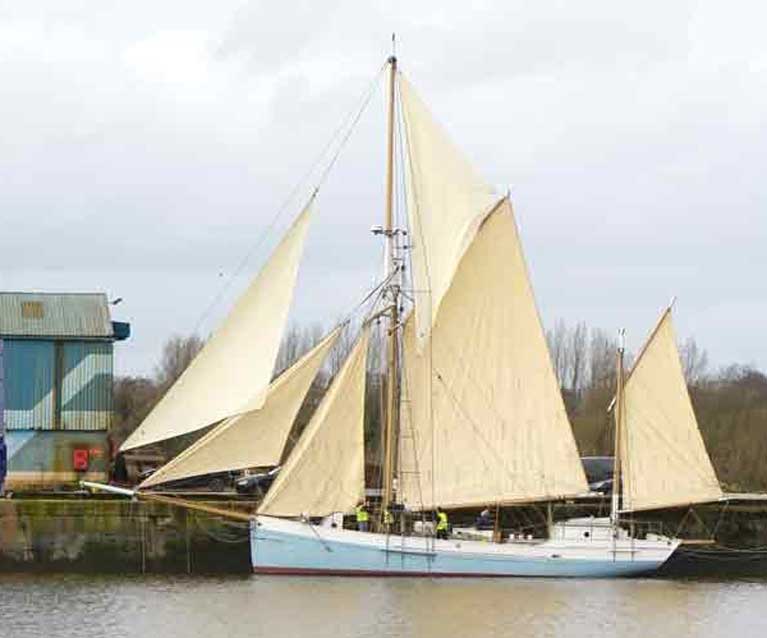 On a gentle day early in 2019 in Limerick, Ilen is finally able to set her complete new suit of fore-and-aft sails. Photo: Gary MacMahon
On a gentle day early in 2019 in Limerick, Ilen is finally able to set her complete new suit of fore-and-aft sails. Photo: Gary MacMahon
He himself is a veteran in this area, as one of his Arctic experiences was with the legendary Paddy Barry aboard the Galway hooker St Patrick, sailing far into northern latitudes.
Paddy Barry has been involved with the Ilen project from an early stage, as he was there at that special moment in November 1997 in Dublin Docks when Ilen was finally unloaded back in Ireland, he was in command when Ilen sailed again for the first time in very many years in Dublin Bay in May 1998, and over the long, challenging years of the restoration, he has been a ready source of encouragement and help.
He and Gary will both be in the ship’s complement for the outward passage to Nuuk and the many activities in Greenland itself. In fact, Paddy will be aboard for the entire nine weeks. But Gary’s time is limited, so for the return passage in August and early September, Paddy Barry will be joined by his partner in the Arctic circumnavigation of the Northabout, Northabout’s original builder, owner and skipper Jarlath Cunnane, and they will share the hugely experienced company of Dr Mick Brogan. These days, he’s best known as an organiser of Cruinnui na mBad at Kinvara, but like the other three, Mick Brogan is a seaman extensively versed in the ways of the Arctic and the needs and challenges of a traditionally-rigged ship.
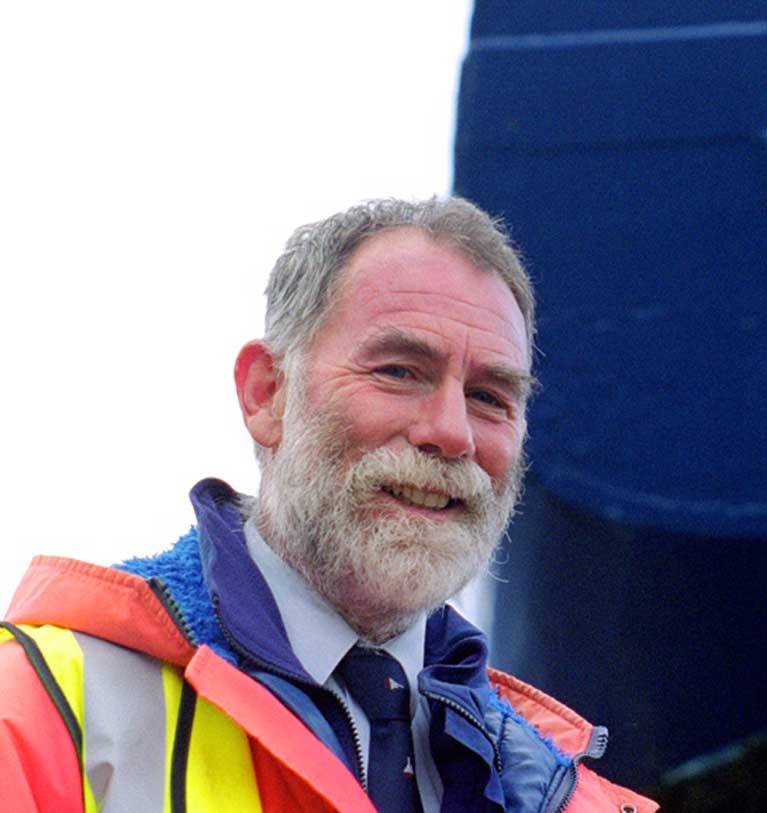 Paddy Barry at the unloading of Ilen in Dublin Port, November 1997. In 2019, he will be aboard throughout the nine weeks Salmons Wake voyage to Greenland. Photo: W M Nixon
Paddy Barry at the unloading of Ilen in Dublin Port, November 1997. In 2019, he will be aboard throughout the nine weeks Salmons Wake voyage to Greenland. Photo: W M Nixon
With Ilen’s departure today (Easter Saturday) from Limerick bound for Baltimore, these latest chapters in an extraordinary story get underway. Conor O’Brien’s account of the original voyage in 1926 from Foynes to the Falklands produced some of his best writing. But now that the old ship has become the Ilen Project, we find the story extending in several directions which somehow take in many places between Venice and Nuuk. It seems that when Gary Mac Mahon gets hold of an idea, all things are possible.
After an eleven year rebuild, last Saturday offered a first opportunity for sending up ‘Ilen’s’ entire suit of sails, save her square sail - a headwind at Limerick Docks precluded its participation.
It might be observed how ‘Ilen’ seems to punch above her weight in the amount of canvas her ketch rig is expected to flying. And this is directly attributable to the pioneering legacy of that inveterate blue water voyager of Irish traditional wooden sailing boats; Conor O’Brien.
When designing the ‘Ilen’s’ rig some five years back the Ilen Project, for better or worse, elected to pay homage to her original Conor O’Brien design rig from 1926. A decision which more than doubled the overall rigging task. Upgrading a traditional coastal ketch rig of three sails to an ocean rig of seven, not to mind all the additional supporting gear, blocks, spars, running and standing rigging is not a small task.
Happily, it has all come together nicely and ‘Ilen’ looks splendid, and nearly ready to embrace the coming sailing season.
Sails in the Attic, Sails on the Ilen & Plastic on the Islands
Joseph Conrad wrote many stories and novels with a nautical setting, based on his time in the British and French merchant marine and in the old sailing ships. They depict trials of the human spirit and one of his memorable quotes is – “The mind of man is capable of anything.”
Perhaps so too is the mind of a marine journalist, because several current images have been coming to its surface.
I am the only Irish marine journalist who was present at the reappearance of the legendary Conor O’Brien’s Ilen when it was brought back to Dublin from the Falkland Islands on the deck of a freighter. I have followed it through the great restoration at Liam Hegarty’s boatyard near Skibbereen, not far from Baltimore where it was originally built.
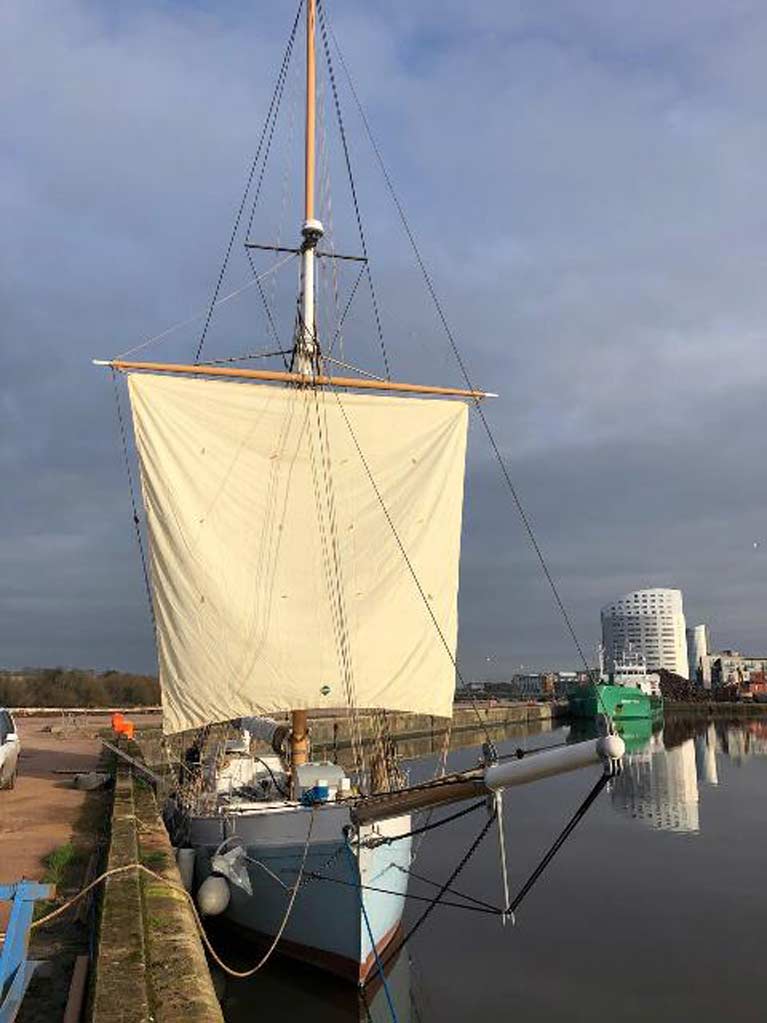 Squaring up on the Ilen
Squaring up on the Ilen
When the square sail, the last of the seven made for it, was raised quietly (shown above) and with not a lot of public attention, in Limerick Port where Ilen is based for the Winter. A very capable, four-sided sail last deployed on the good ship some 92 years ago… an image invoking an emotive sense of pride in the achievements of those who restored and rehabilitated her….
People can do wonderful things in the marine sphere and that was added to when I was sent the other photo here, from Clare Island, because the offshore islands are not, in my view, given the attention they should get and it has been overlooked that, in the current battle against plastic pollution of the oceans they are amongst the first recipients of this waste…
"Listen to the Podcast to hear more about how the offshore islands are dealing with plastic and other pollution"
Listen to the Podcast below to hear more about how the offshore islands are dealing with plastic and other pollution that is increasingly washing up on their shores and particularly Clare Island, a lovely island to sail into… and also about my third image… what do you do with old sails?
 Clare Islanders have built a bungalow from waste plastic bottles
Clare Islanders have built a bungalow from waste plastic bottles
Listen to the Podcast below
In ancient Greece, the Halcyon Days were a mythological seven day period of calm clear weather at the mid-winter Solstice writes W M Nixon. Down Limerick way, they’ve been making the best of the Halcyon Days, with the blue River Shannon ruffled only by the gentlest of breezes for several days now, while the sun has shone on the Ted Russell Dock where the restored 56ft 1926-built gaff ketch Ilen has seen continuing work by the Ilen Project team.
Various tasks have been ongoing to have her ready for the 2019 season, which will include a round Ireland voyage with a significant visit to Dun Laoghaire. And since Ilen returned to Limerick at the beginning of October, she has been much-visited by a wide range of people including President Michael D Higgins and groups of schoolchildren taking part in the interactive educational projects linked to the historic ship.
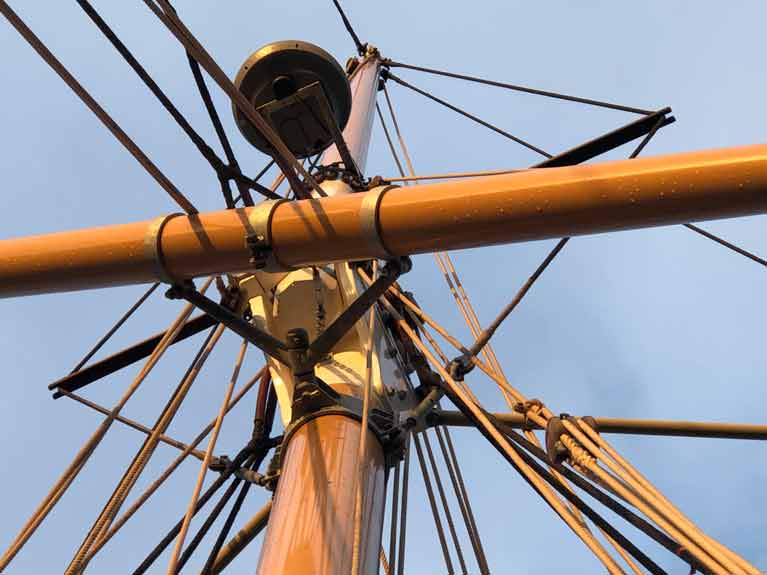 The power exerted by the squaresail demands substantial fittings – the transverse yard itself was specially designed by the late Theo Rye. Photo: Gary MacMahon
The power exerted by the squaresail demands substantial fittings – the transverse yard itself was specially designed by the late Theo Rye. Photo: Gary MacMahon
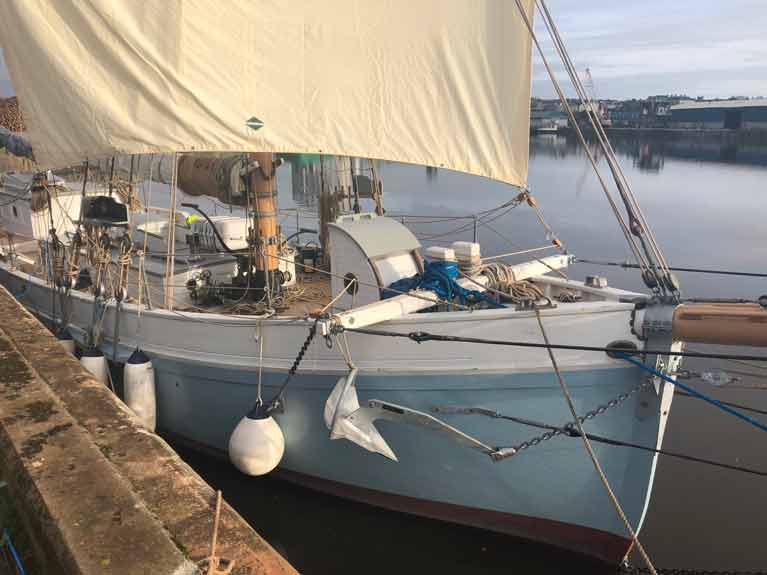 The proper sheeting of squaresails is almost a forgotten art – thanks to the forward lead to the cathead, Ilen’s topsail can be usefully carried on a reach. Photo: Gary MacMahon
The proper sheeting of squaresails is almost a forgotten art – thanks to the forward lead to the cathead, Ilen’s topsail can be usefully carried on a reach. Photo: Gary MacMahon
But while she is so important historically, the Ilen nevertheless has to project an attractive persona, and one of the useful things about the holiday period is that it provided opportunities to see the re-born Ilen at leisure, with the “small tall ship” in an uncrowded state. It is then that her true spirit shines through, and you appreciate why Project Leader Gary MacMahon chose the special colour schemes he did. For as one visitor seeing the ship for the first time commented: “The Ilen looks so jaunty – she cheers everyone up”.
"a round Ireland voyage with a significant visit to Dun Laoghaire"
There was further cause for cheer in recent days when the newly-arrived traditional squaresail, exactly as designed by Conor O’Brien of Foynes Island back in 1926, was offered up to its spars and equipment – and fitted perfectly. So it’s only a matter of time before that long and distinctive bowsprit re-emerges from the sea lock into the Estuary, and we see Ilen setting full sail for the first time in many decades.
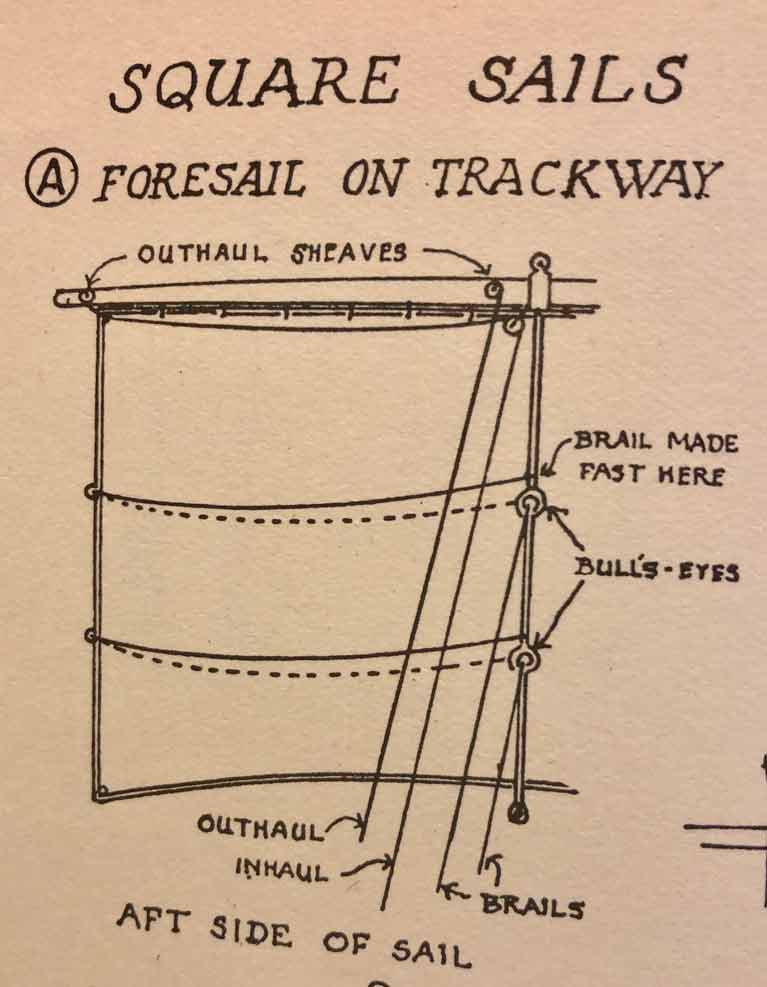 Back to the original – Conor O’Brien’s drawings for squaresail control
Back to the original – Conor O’Brien’s drawings for squaresail control
Meanwhile, for those who would like a comprehensive overview of this very special project, the profusely-illustrated and comprehensive Ilen Report 2018 has just been published as a generous 32-page fully-coloured booklet, and is available free both as this Ilen_Report_Final.pdf, and in hard copy from [email protected]
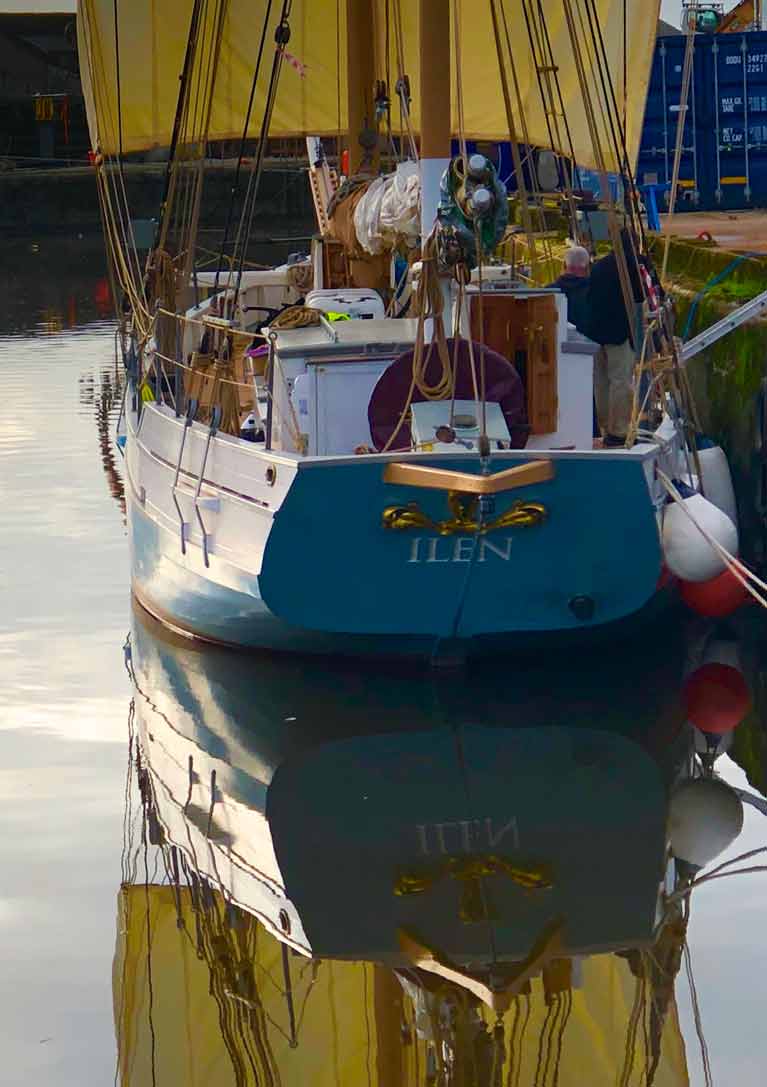 Reflections on a peaceful evening of early January in Limerick. A year ago, the weather was very different, and Ilen was facing a difficult launching operation and berthing move in the crowded boatyard at Oldcourt in West Cork. Photo: Gary MacMahon
Reflections on a peaceful evening of early January in Limerick. A year ago, the weather was very different, and Ilen was facing a difficult launching operation and berthing move in the crowded boatyard at Oldcourt in West Cork. Photo: Gary MacMahon




























